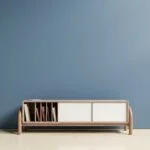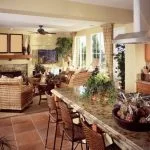The early 1900s was a time of immense creativity and innovation in the world of interior design. Home decor during this period showcased a range of styles, from the opulence of the Victorian era to the simplicity of the Arts and Crafts movement, and the organic forms of Art Nouveau. Even today, these design influences continue to captivate homeowners and designers worldwide.
The fascination with early 1900s home decor is rooted in its timeless elegance. The elaborate designs and intricate details of Victorian home decor still hold a certain allure, while the clean lines and natural materials used in the Arts and Crafts movement inspire a sense of simplicity and functionality. Additionally, the flowing lines and nature-inspired motifs of Art Nouveau bring an organic charm to any space.
In this article, we will explore how each style from the early 1900s offers unique aesthetic appeal that can be incorporated into modern living spaces. From the grandeur of the Victorian era to the sleek modernity of the Roaring Twenties, we will dive into each design period’s defining characteristics, providing tips on how to recreate these looks in your own home.
Prepare to be inspired as we unlock the secrets behind preserving and reviving early 1900s home decor in today’s interiors.
The Victorian Era
The Victorian Era is known for its opulent and ornate home decor, characterized by elaborate designs and extravagant details. This section will delve into the distinctive features of Victorian home decor, highlighting the use of rich colors, heavy fabrics, and intricate patterns.
Elaborate Designs and Extravagant Details
Victorian home decor is all about luxurious and grandiose aesthetics. During this era, homes were adorned with intricate moldings, ornate wallpaper, and decorative elements such as ceiling medallions and corbels. Rooms were often filled with furniture pieces featuring curved lines, intricate carvings, and detailed upholstery. Every aspect of the space was thoughtfully designed to create a visually stunning environment.
Rich Colors and Heavy Fabrics
In terms of color palette, Victorian home decor favored deep, rich hues. Jewel tones like ruby reds, sapphire blues, emerald greens, and amethyst purples were commonly used to create a sense of richness and elegance. These vibrant colors often paired with heavy fabrics like velvet or damask to further enhance the opulence of the space. Draperies would be floor-length and heavily layered for a dramatic effect.
Intricate Patterns
Victorian home decor also embraced intricate patterns in every aspect of design. Floral motifs were especially popular in wallpaper designs, upholstery fabrics, and even carved details on furniture pieces. Other common patterns included paisleys, stripes, brocade patterns, and damask designs. The attention to detail extended to every surface in a room – from rugs with elaborate Persian-inspired designs to china sets featuring delicate floral patterns.
The Victorian Era’s emphasis on opulent beauty has had a lasting impact on home decor throughout history. Even today, elements of Victorian design continue to captivate homeowners who seek to create a lavish atmosphere within their living spaces.
The Arts and Crafts Movement
The Arts and Crafts Movement was a significant design movement in the early 1900s that responded to the industrialization and mass production of goods during that time. It emphasized a return to craftsmanship, simplicity, and functionality in home decor. This movement sought to create a harmonious blend of art and everyday life, focusing on handmade craftsmanship and natural materials.
In terms of home decor, the Arts and Crafts Movement embraced clean lines, unadorned surfaces, and natural materials such as wood, stone, and metals. Furniture pieces were often handcrafted with attention to detail, showcasing the beauty of natural grain patterns. The emphasis was on functional designs that were both practical and aesthetically pleasing.
One notable figure associated with this movement is William Morris, an influential designer who believed that everyone should have access to well-designed objects in their homes. Morris advocated for high-quality craftmanship as a means to improve people’s daily lives. His ideas influenced the creation of distinctive wallpaper, furniture, textiles, ceramics, and stained glass designs that reflected the beauty of nature.
To incorporate the Arts and Crafts style into your own home decor today, consider these tips:
- Choose natural materials: Opt for furniture made from wood or other natural materials like stone or metal. Look for pieces with clean lines and minimal ornamentation.
- Prioritize functionality: Select furniture pieces that serve a purpose beyond just aesthetics. Look for built-in storage solutions or multi-functional pieces that can adapt to your needs.
- Incorporate handmade elements: Include handcrafted items such as textiles with intricate weaving or pottery crafted by local artisans.
- Embrace earthy color palettes: Use warm earth tones like deep browns, rich greens, rusty oranges, and muted yellows in your paint choices or upholstery fabrics.
By embracing the principles of simplicity and functionality in the Arts and Crafts Movement, you can create a timeless and inviting atmosphere in your home that celebrates craftsmanship and natural beauty.
Art Nouveau
Art Nouveau, a significant design movement that emerged in the late 19th century, played a significant role in shaping the early 1900s home decor. This section will explore the influence of Art Nouveau on interior design during this period and highlight key characteristics associated with this aesthetic. From flowing lines to floral motifs and decorative elements inspired by nature, Art Nouveau brought an entirely new approach to home decor.
The Influence of Art Nouveau
Art Nouveau was characterized by its celebration of nature’s curves and organic forms. In contrast to the ornate and elaborate designs of the Victorian era, Art Nouveau sought to capture the natural beauty found in the world around us. Inspired by plant forms, such as flowers and leaves, designers embraced curvilinear lines that mimicked the elegance and fluidity found in nature.
The popularity of Art Nouveau spread throughout Europe and North America during the early 1900s. It had a profound impact on various aspects of design, including architecture, furniture, textiles, and decorative arts. The movement was not only limited to physical objects but also influenced graphic design, typography, and advertising.
Key Elements of Art Nouveau Home Decor
One of the defining elements of Art Nouveau home decor was the use of flowing lines. Organic curves were incorporated into every aspect of interior design, from architectural details like doorways and arches to furniture pieces like chairs and tables. These sinuous lines added a sense of gracefulness and harmony to spaces.
Floral motifs were another prominent feature in Art Nouveau home decor. Flowers such as irises, lilies, poppies, and peonies were often depicted in various decorative elements like stained glass windows, wallpapers, textiles, and ceramics. These botanical designs added a touch of whimsy and natural beauty to interiors.
In addition to flowing lines and floral motifs, other decorative elements inspired by nature were prevalent in Art Nouveau home decor. Designs were often characterized by the inclusion of insects, birds, and other animals, as well as motifs inspired by shells, waves, and the movement of water.
Overall, Art Nouveau brought a refreshing departure from the ornate and heavy designs of previous eras. Its emphasis on natural beauty and organic forms created a sense of harmony and tranquility within living spaces. Today, many homeowners appreciate the timeless elegance of Art Nouveau and seek to incorporate its elements into their own homes.
The Roaring Twenties
During the 1920s, a dramatic shift occurred in home decor as people embraced the modern ideals of the Jazz Age. This era was characterized by a departure from the opulence of previous decades and a focus on streamlined design, geometric shapes, and bold colors. The influence of modern technology also played a significant role in shaping home design during this period.
One prominent feature of 1920s home decor was the use of geometric shapes. Furniture became more angular and streamlined, with sharp lines replacing the ornate details of earlier styles. Geometric patterns were also popular in wallpapers, rugs, and textiles, adding a sense of vibrancy and energy to spaces. Art Deco, an influential design movement during this time, epitomized the use of bold geometry in home decor.
The color palette of the Roaring Twenties was equally striking. Bright and bold hues such as deep blues, rich purples, vibrant reds, and shimmering golds were used to create a visually stimulating atmosphere. These colors were often paired with contrasting black or white accents to enhance their impact. In addition to bright tones, metallic finishes such as chrome and silver were utilized for furniture pieces and accessories to add a touch of glamour and modernity.
| Geometric Shapes | Bold Colors |
|---|---|
| The use of sharp lines and angular forms replaced ornate details | Bright hues like deep blues, rich purples, vibrant reds |
| Geometric patterns found in wallpapers, rugs, textiles | Contrasting black or white accents to enhance impact |
| Art Deco movement epitomized bold geometry in decor | Metallic finishes like chrome and silver for glamour |
The influence of modern technology also had a significant impact on home design during the Roaring Twenties. The introduction of electric lighting allowed for more flexibility in creating dramatic and creative lighting schemes, resulting in atmospheric spaces with a touch of Hollywood glamour.
The popularity of telephones led to the creation of telephone nooks or alcoves, which became fashionable additions to homes for holding private conversations. Additionally, built-in cabinetry and storage solutions were incorporated into homes as a response to the increasing need for organized and efficient living spaces.
As we enter the 21st century, the design elements of the Roaring Twenties continue to inspire homeowners and designers alike. Incorporating geometric shapes, bold colors, and nods to modern technology can bring a sense of energy and vitality into contemporary living spaces. By embracing the spirit of the Jazz Age and blending it with our current aesthetic preferences, we can create unique interiors that pay homage to this iconic era while still feeling fresh and relevant.
Overall, the 1920s was a time when home decor celebrated progress, innovation, and style. The embrace of modernity in design during this era remains influential today, reminding us that even a century later, there is still much inspiration to be found in the artistic trends of the past.
Sources:
- Anderson J (2019) The Roaring Twenties: Art Deco Home Decor Ideas.
- Finnigan TJ (2005) Art Deco: A Guide for Collectors
– Holmes L (2021) Top 10 Art Deco Home Decorating Ideas.
The Influence of Technology
The early 1900s were a transformative time in home design, as advancements in technology began to shape and influence the way houses were built and decorated. The influence of technology on home design during this period can be seen in various innovative features that were introduced to make life more convenient and comfortable for homeowners.
One significant advancement was the introduction of electric lighting. Prior to this, homes relied on gas lamps or candles for illumination, which were not only expensive but also posed fire hazards.
With the development and widespread adoption of electricity, homeowners now had the luxury of being able to illuminate their homes with just a flip of a switch. This revolutionized interior design by allowing spaces to be designed with artificial lighting in mind, such as pendant lights and chandeliers as focal points.
Another technological adaptation in home design was the inclusion of telephone nooks. As telephones became more common in households, homeowners needed a designated space to place their telephones. Nooks or small alcoves were created near entryways or living areas where phone lines could be easily accessed. These telephone nooks became an integral part of early 1900s home decor, often incorporating decorative elements like intricate woodwork or stained glass to add elegance to the space.
Built-in cabinetry also became popular during this time due to advancements in woodworking techniques and machinery. Homeowners now had the option to have custom cabinets designed and constructed directly into their homes’ architecture instead of relying on standalone pieces of furniture. These built-ins provided storage solutions while seamlessly blending with the overall design of the house. In early 1900s home decor, built-in cabinetry often featured intricate details like decorative moldings or leaded glass doors.
The influence of technology on early 1900s home design cannot be understated. Advancements like electric lighting, telephone nooks, and built-in cabinetry transformed houses into modern living spaces that were both functional and aesthetically pleasing. These technological adaptations continue to inspire and influence modern home decor, as homeowners today can incorporate elements from the early 1900s to create a timeless and elegant interior design.
Revival and Reproduction
The early 1900s home decor aesthetic continues to captivate homeowners and designers today. With its timeless elegance and charm, it is no wonder that there has been a resurgence in the revival and reproduction of this style. Many people are drawn to the nostalgia and romanticism of this era, seeking to recreate its unique atmosphere in their own living spaces.
One way to recapture the charm of early 1900s home decor is through the use of authentic pieces from that time period. Antique furniture, such as ornately carved wooden dining tables or claw-footed sofas, can instantly transport a room back in time. Vintage accessories like crystal chandeliers, porcelain vases, and intricately framed mirrors also add an air of sophistication and old-world charm.
For those who are unable to find original pieces or prefer new items with a vintage look, reproductions are readily available. Many furniture manufacturers now offer pieces inspired by the early 1900s design styles. These reproductions often feature the same attention to detail and craftsmanship as their original counterparts but are made with modern materials for added durability and convenience.
Incorporating architectural elements from the early 1900s can also help recapture the charm of this era in your home. Consider adding decorative crown molding or chair rails for a touch of elegance. Stained glass windows or doors can introduce a vibrant burst of color while invoking a sense of grandeur. Wallpaper with intricate patterns reminiscent of the Victorian era or Art Nouveau movement can be used to create a stunning focal point on accent walls.
Reviving and reproducing early 1900s home decor allows us to appreciate the beauty and craftsmanship of this bygone era while creating unique and charming living spaces today. Whether through authentic antiques or carefully selected reproductions, incorporating elements from this time period adds a touch of nostalgia and history to our homes. By embracing this timeless aesthetic, we can recapture the charm of early 1900s home decor and create spaces that are both visually stunning and deeply meaningful.
Tips and Inspiration
The early 1900s home decor style continues to captivate homeowners and interior designers today. With its timeless elegance and rich history, incorporating elements of this aesthetic can add a touch of vintage charm to any modern space. Whether you’re looking to fully embrace this style or simply add a few inspired pieces, here are some tips and inspiration on how to incorporate early 1900s home decor in your space.
Color palettes play a vital role in capturing the essence of early 1900s home decor. Consider using warm, earthy tones such as deep reds, olive greens, and mustard yellows for walls or furniture. These colors were popular during this era and will help create an inviting atmosphere reminiscent of the time period. Pastels such as pale pinks and blues were also commonly used in Victorian-era homes, adding a softer and more feminine touch.
Furniture choices should reflect the ornate yet functional aspects of early 1900s home decor. Look for pieces that feature intricate carvings, curved lines, and details like claw feet or tufted upholstery.
Dark wood finishes such as mahogany or walnut were prevalent during this time period and can easily be incorporated into your space through tables, chairs, or cabinets. Additionally, incorporating statement furniture pieces like an elegant chaise lounge or a grand four-poster bed can instantly transport your space back in time.
When it comes to decorative accents, think about incorporating vintage-inspired wallpapers with intricate patterns or floral motifs that were common in both Victorian and Art Nouveau styles. Adding antique mirrors with decorative frames can make a stunning focal point while also reflecting natural light throughout the room. Don’t forget about lighting too – opt for fixtures that feature stained glass shades or crystal embellishments for an added touch of glamour.
By carefully selecting colors, furniture choices, and decorative accents that align with early 1900s home decor styles, you can create a beautiful homage to the past while still maintaining a comfortable and functional living space. Let this timeless aesthetic inspire you to explore the possibilities and truly make your house feel like a home from another era.
| Aspect | Tips and Inspiration |
|---|---|
| Color Palettes | – Use warm, earthy tones like deep reds, olive greens, and mustard yellows for walls or furniture.
|
| Furniture Choices | – Look for pieces with intricate carvings, curved lines, and details like claw feet or tufted upholstery.
|
| Decorative Accents | – Incorporate vintage-inspired wallpapers with intricate patterns or floral motifs.
|
Conclusion
In conclusion, early 1900s home decor continues to captivate and inspire homeowners and designers alike with its timeless beauty. From the opulent and ornate Victorian era to the simplicity and functionality of the Arts and Crafts movement, each style offers its own unique charm that can be incorporated into modern living spaces. The influence of Art Nouveau also cannot be overlooked, as it celebrates nature’s curves and organic forms in a way that is both elegant and innovative.
The shift towards modernity in the 1920s brought about a new wave of design elements, characterized by geometric shapes, streamlined furniture, and bold colors. This era embraced innovation and embraced technology, which greatly impacted home decor through features such as electric lighting, telephone nooks, and built-in cabinetry.
Today, there is a strong revival of early 1900s home decor as homeowners seek to recapture the charm and elegance of this bygone era. Whether through authentic vintage pieces or high-quality reproductions, incorporating elements from this time period can bring a sense of history and character to any space. By following practical tips on color palettes, furniture choices, and decorative accents, individuals can successfully achieve the desired aesthetic in their own homes.
Frequently Asked Questions
How to decorate a home from the early 1900s?
Decorating a home from the early 1900s requires a keen understanding of the design principles and aesthetics prevalent during that time. This era was marked by a focus on elegance, craftsmanship, and ornate details. To capture the essence of this period, homeowners can consider incorporating architectural elements such as crown molding, wainscoting, and intricate trim work. When it comes to color palettes, soft and muted tones were popular choices in the early 1900s.
Incorporating traditional patterns like damask or floral prints into upholstery fabrics or wallpapers can help evoke the ambiance of that time. Furniture from this era often featured carved wood details and curved lines, emphasizing grace and sophistication. Including antique pieces or replicating those styles with modern selections can bring an authentic touch to the overall decor.
What design style was in the early 1900s?
The design style that dominated the early 1900s is commonly referred to as “Edwardian” or “Belle Époque” style. This design aesthetic emerged during King Edward VII’s reign in Britain (1901-1910) but had influences throughout Europe and North America as well. The Edwardian era emphasized grandeur, luxury, and a sense of refinement in interior design.
This style was heavily influenced by Art Nouveau, featuring organic forms inspired by nature and intricate detailing. In terms of color schemes, Edwardian interiors often embraced pastels such as pale pinks, blues, greens, or lavenders to create an airy and delicate atmosphere. Ornamentation played a key role in this design style; decorative plasterwork on ceilings and walls became quite popular during this period.
What did houses look like in the early 1900s?
Houses in the early 1900s showcased various architectural styles such as Victorian, Queen Anne Revival, Arts and Crafts movement influenced designs, Neo-Colonial styles inspired by earlier periods like Georgian or Federal architecture, among others shaping residential landscapes across different regions globally. These houses typically exhibited distinctive features like steeply pitched roofs, wrap-around porches, asymmetrical facades, bay windows, and elaborate decorative elements. Exterior materials varied from brick to stone or wood siding depending on the region and prevailing architectural styles of that area. The interiors of these houses often boasted high ceilings with ornate plaster moldings, elaborate woodwork details, stained glass windows, and grand staircases.
The layout generally included separate rooms for specific purposes like living areas, dining spaces, libraries, and bedrooms. Some houses from this time might have had dedicated servants’ quarters since domestic help was more common during that period. Overall, early 1900s houses exuded charm and displayed the intricacies of the architectural styles popular during that era.

I’m thrilled to be your companion on this exciting journey through the world of home decor and design. With a passion for turning houses into homes and a keen eye for the finer details, I’m here to help you transform your living spaces into beautiful, functional, and meaningful havens.





